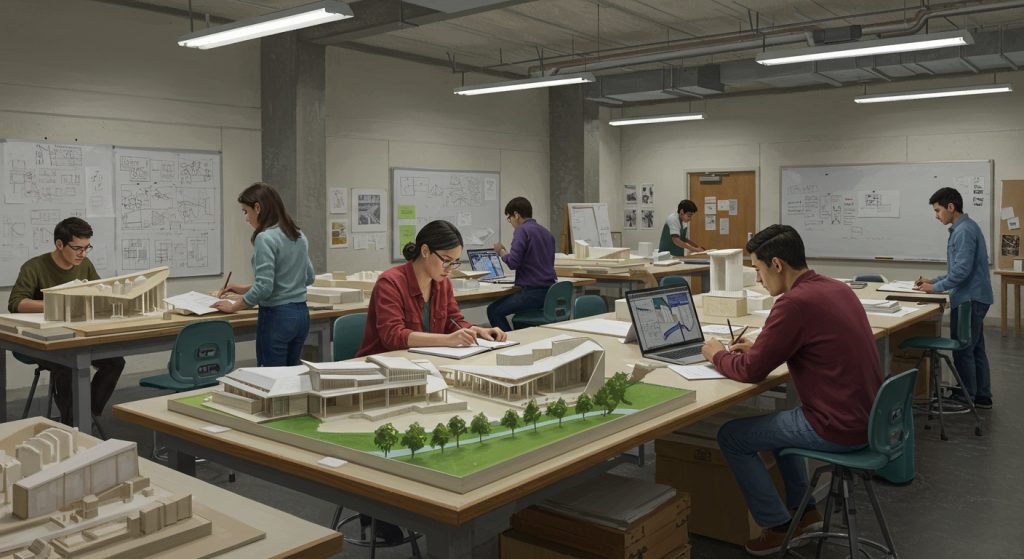The architectural landscape is shifting. Today’s graduates face demands exceeding traditional design skills, requiring fluency in parametric modeling, sustainable practices. Collaborative project delivery. Schools are adapting. Some forge stronger industry connections than others. These institutions actively integrate real-world projects, offer internships with leading firms like SOM and Gensler. Invite guest lecturers who are shaping the future of urban design. Choosing the right program means more than just studio space; it means access to cutting-edge software training, networking opportunities that can launch a career. A curriculum reflecting the latest advancements in building technology. Assessing which colleges prioritize these connections is critical for aspiring architects aiming to thrive in a competitive field.

Why Industry Connections Matter in Architecture Education
Choosing an architecture college is a significant decision, one that will shape your career trajectory. While a strong academic foundation is crucial, the importance of industry connections cannot be overstated. These connections bridge the gap between theoretical knowledge and real-world practice, offering invaluable opportunities for students to gain experience, build their professional network. Enhance their employability.
Industry connections in Architecture colleges can manifest in various forms, including:
- Internships
- Guest Lectures
- Workshops
- Studio Projects
- Career Fairs
- Mentorship Programs
Providing hands-on experience in architectural firms.
Featuring practicing architects and industry experts sharing their insights.
Offering practical skills training in areas like BIM software, sustainable design, or construction management.
Collaborating with real clients on design challenges.
Connecting students with potential employers.
Pairing students with experienced architects for guidance and support.
These connections translate into a more well-rounded education, making graduates more competitive in the job market. They also provide a realistic understanding of the challenges and rewards of a career in Architecture.
Key Indicators of Strong Industry Ties
Identifying architecture colleges with robust industry connections requires careful research. Here are several key indicators to look for:
- Faculty with Industry Experience
- Internship Programs
- Guest Speaker Series
- Accreditation
- Alumni Network
- Career Services
- Collaboration on Research Projects
Professors who have worked as practicing architects bring real-world perspectives into the classroom and often maintain connections to their former firms.
The availability and quality of internship opportunities are crucial. Look for colleges with established partnerships with reputable architectural firms.
A regular program of guest lectures by practicing architects and industry experts indicates a commitment to connecting students with the profession.
Accreditation by organizations like the National Architectural Accrediting Board (NAAB) often requires demonstrating industry engagement.
A strong alumni network can provide valuable mentorship and networking opportunities.
A dedicated career services department can assist students with resume writing, interview preparation. Job placement.
Architecture schools that engage in collaborative research projects with industry partners provide students with valuable exposure to cutting-edge technologies and practices.
Evaluating Internship Programs: What to Look For
Internships are arguably the most valuable form of industry connection. When evaluating internship programs, consider the following:
- Variety of Opportunities
- Structure and Support
- Credit for Internships
- Feedback and Evaluation
- Internship Placement Rate
Does the college offer internships in a range of architectural firms, from small boutique firms to large international practices?
Does the college provide support to students during their internships, such as site visits or mentorship?
Does the college offer academic credit for internships, recognizing their educational value?
Are students provided with feedback on their performance during internships?
What percentage of students successfully complete internships?
Ideally, internship programs should provide students with hands-on experience in a variety of areas, such as design, construction documentation. Project management. The best programs also offer opportunities for students to network with professionals and build their portfolios.
The Role of Faculty in Fostering Industry Relationships
Faculty play a critical role in building and maintaining industry relationships. Professors with industry experience can leverage their connections to create opportunities for students, such as internships, guest lectures. Studio projects. They can also provide valuable insights into the current trends and challenges in the field of Architecture.
Look for architecture colleges that have a mix of full-time faculty with academic credentials and adjunct faculty who are practicing architects. Adjunct faculty bring a fresh perspective and real-world experience into the classroom.
Moreover, faculty involvement in professional organizations, such as the American Institute of Architects (AIA), can help to strengthen industry connections and provide students with access to networking opportunities.
Leveraging Alumni Networks for Career Advancement
A strong alumni network can be a valuable resource for architecture students. Alumni can provide mentorship, networking opportunities. Even job leads. Look for architecture colleges with active alumni associations that organize events and provide opportunities for students to connect with graduates.
Some colleges even have alumni mentorship programs that pair students with experienced architects for guidance and support. These programs can be invaluable for students who are just starting their careers.
Consider researching alumni career paths: where do graduates of the program end up working? Are they in firms you admire? Are they leaders in the Architecture community?
Beyond Internships: Other Avenues for Industry Engagement
While internships are a primary form of industry connection, several other avenues can provide valuable experience and networking opportunities:
- Design Competitions
- Community Design Projects
- Research Collaborations
- Workshops and Seminars
Participating in design competitions, such as those sponsored by the AIA or other professional organizations, can provide students with valuable exposure and recognition.
Working on community design projects, such as designing affordable housing or revitalizing public spaces, can provide students with hands-on experience and a chance to make a difference in their communities.
Collaborating with faculty on research projects with industry partners can provide students with exposure to cutting-edge technologies and practices. For example, a project might involve using BIM (Building details Modeling) to optimize the energy efficiency of a building. BIM is a process that involves creating a digital representation of a building’s physical and functional characteristics.
Attending workshops and seminars on topics such as sustainable design, construction management, or BIM software can provide students with valuable skills and knowledge.
The Impact of Technology on Industry Connections
Technology plays an increasingly vital role in Architecture. Industry connections can help students stay abreast of the latest trends. Colleges that have strong relationships with software vendors, such as Autodesk (makers of AutoCAD and Revit), can provide students with access to cutting-edge tools and training.
Moreover, technology facilitates remote collaboration and communication, making it easier for students to connect with architects and firms around the world. Virtual internships and online workshops are becoming increasingly common, providing students with opportunities to gain experience and network with professionals even if they are not able to travel.
For example, some Architecture firms are now using Virtual Reality (VR) and Augmented Reality (AR) to visualize designs and collaborate with clients. Colleges that incorporate these technologies into their curriculum and provide students with opportunities to work with them are preparing them for the future of the profession.
Examples of Architecture Colleges with Strong Industry Connections
While a comprehensive list is beyond the scope of this article, here are a few examples of architecture colleges that are known for their strong industry connections. Remember to research each college thoroughly to ensure that it meets your specific needs and interests.
- Massachusetts Institute of Technology (MIT)
- Harvard University Graduate School of Design (GSD)
- Columbia University Graduate School of Architecture, Planning and Preservation (GSAPP)
- University of California, Berkeley
- Southern California Institute of Architecture (SCI-Arc)
MIT’s Department of Architecture has a strong reputation for research and innovation. It has close ties to the architecture and construction industries.
Harvard GSD is known for its rigorous academic program and its strong alumni network. It also has a variety of programs that connect students with practicing architects and designers.
Columbia GSAPP is located in New York City, which provides students with access to a wide range of architectural firms and cultural institutions.
UC Berkeley’s College of Environmental Design has a strong focus on sustainability and social justice. It has close ties to the architecture and urban planning communities in the Bay Area.
SCI-Arc is known for its experimental and innovative approach to architecture. It has strong ties to the architecture and design communities in Los Angeles.
This is not an exhaustive list and it’s crucial to do your own research, considering factors such as location, program focus. Faculty expertise when making your decision.
Conclusion
Choosing the right architecture college is more than just picking a name; it’s about launching your career. This guide has highlighted institutions that prioritize industry engagement. But remember, the connection is a two-way street. Proactively attend workshops, network with visiting professionals. Seek out internships. Looking ahead, architecture is embracing sustainable practices and digital fabrication. Equip yourself with skills in these areas. My personal tip? Don’t be afraid to reach out to alumni. Their real-world experience is invaluable. The most successful architects are not just designers. Collaborators and innovators. Embrace this spirit. Your architectural journey will be filled with possibilities.
More Articles
Top Schools for Architecture In Netherlands
Best Colleges For Computer Science with Industry Placements
Affordable Engineering Colleges In India With High ROI
FAQs
So, what exactly do you mean by ‘strong industry connections’ when talking about architecture colleges?
Good question! , it means the college has solid relationships with architecture firms, construction companies, design studios. Other related businesses. This translates to things like internships, guest lectures from professionals, workshops led by industry experts. Even job opportunities after graduation. Think of it as a fast track into the real world of architecture.
Why are these industry connections even vital? Can’t I just learn everything I need from textbooks?
While textbooks are great for the theory, architecture is a very practical field. Industry connections give you invaluable real-world experience. You get to see how things are actually done, network with potential employers. Build a portfolio that showcases your skills beyond just classroom projects. It’s the difference between knowing the recipe and actually cooking a delicious meal.
Okay, that makes sense. How do I even find out which colleges have these strong connections? Is there some secret list?
No secret list, unfortunately! But you can do some digging. Check a college’s website for data on their internship programs, alumni networks. Guest speaker series. Look for faculty members who are actively involved in professional practice. Also, don’t be afraid to reach out to current students or alumni and ask about their experiences with industry connections.
What kind of internship opportunities should I be looking for?
Ideally, you want internships that offer hands-on experience and allow you to contribute to real projects. Look for firms that are doing work you’re interested in, whether it’s residential design, sustainable architecture, urban planning, or something else entirely. Don’t be afraid to start small and work your way up!
Besides internships, what other opportunities should I keep an eye out for?
Definitely look for opportunities to participate in design competitions, attend industry conferences. Join student organizations related to architecture. These activities will help you build your network, learn about current trends in the field. Showcase your skills to potential employers.
Is it worth paying more for a college with better industry connections?
That’s a tough one. Depends on your individual circumstances. Weigh the cost of tuition against the potential benefits of strong industry connections, such as better job prospects and a higher starting salary. Think of it as an investment in your future career. If the connections genuinely open doors, it might be worth the extra cost.
Let’s say I get into a college with great connections. How can I actually use them effectively?
Be proactive! Attend networking events, introduce yourself to guest speakers. Build relationships with your professors. Don’t be afraid to ask for advice or guidance. And most importantly, be prepared to put in the work. Industry connections can open doors. It’s up to you to walk through them and make the most of the opportunities.



